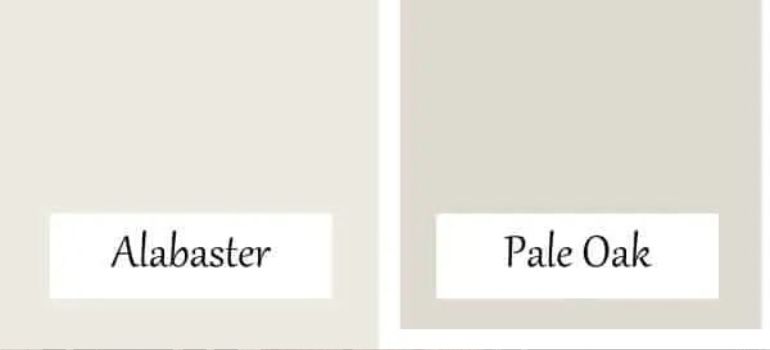Introduction
When it comes to painting your home, selecting the right color can be a daunting task. Two popular choices that often make it to the top of the list are Pale Oak and Alabaster. In this article, we will explore the differences between these two shades and help you decide which one is the perfect fit for your living spaces.
The Battle of the Neutrals
Choosing a neutral paint color can be challenging, but it’s an excellent way to create a timeless and elegant look in your home. Pale Oak and Alabaster are both neutral shades that offer versatility and sophistication. Let’s delve into their characteristics and applications.
Understanding Pale Oak
Pale Oak, a subtle and warm neutral, belongs to the Benjamin Moore family of paint colors. It’s known for its soft undertones and delicate appearance. Here’s what you need to know:
Warm Undertones
Pale Oak exhibits warm undertones, which make it an excellent choice for creating a cozy and inviting atmosphere in your home. It complements a wide range of interior styles.
Light Reflectance
This shade has high light reflectance, making any room feel more spacious and airy. It’s particularly suitable for smaller spaces or rooms with limited natural light.
Versatility
Pale Oak’s versatility shines through in its ability to pair well with various accent colors and furnishings. Whether you prefer a modern or traditional look, Pale Oak can adapt seamlessly.
Discovering Alabaster

On the other hand, Alabaster, a popular paint color from Sherwin-Williams, has its unique qualities that set it apart:
Pure and Crisp
Alabaster is a pure white with subtle hints of warmth. It delivers a clean and crisp appearance, making it a favorite for a timeless and classic look.
Versatility
Like Pale Oak, Alabaster is incredibly versatile and can complement a wide array of decor styles, from farmhouse to contemporary.
Enhanced Natural Light
Alabaster’s reflective properties can enhance natural light in your space, giving it a fresh and inviting feel.
Choosing Between Pale Oak and Alabaster
Now that we’ve explored the characteristics of both shades, it’s time to decide which one suits your needs:
Factors to Consider
Lighting
Consider the natural light in your space. If you have ample natural light, Alabaster can create a clean and airy feel. For rooms with limited light, Pale Oak’s warmth can make them cozier.
Interior Style
Your interior style plays a crucial role. If you lean towards a classic, timeless look, Alabaster might be your choice. For a more flexible and adaptable option, Pale Oak is a great pick.
Color Coordination
Think about the colors of your existing furniture and decor. Both Pale Oak and Alabaster can work well with a variety of color schemes, but consider which one complements your existing pieces.
Exploring Paint Application Tips

Now that you’ve decided on Pale Oak or Alabaster for your home, let’s discuss some essential tips for a successful paint application:
Surface Preparation
Before painting, ensure that your surfaces are clean and properly prepared. Fill any holes or cracks, sand rough areas, and apply a suitable primer if needed.
Quality Paint and Tools
Invest in high-quality paint and tools for a professional finish. Good brushes, rollers, and paint trays can make a significant difference in the final result.
Test Samples
To be absolutely sure about your choice, test paint samples on a small section of your wall. This will give you a better idea of how the color looks in your specific lighting conditions.
Multiple Coats
Most neutral shades, including Pale Oak and Alabaster, may require more than one coat for full coverage. Be prepared to apply additional coats as needed.
Paint with Care
Take your time when applying the paint. Start with the edges and corners using a brush, and then use a roller for larger areas. Avoid drips and streaks for a smooth finish.
Allow Proper Drying Time
Follow the manufacturer’s recommendations for drying times between coats. Rushing through the process can lead to uneven results.
Finishing Touches
Once you’ve completed the main coats, inspect your work for any touch-ups or imperfections. Address them promptly for a flawless appearance.
Maintenance and Care
Maintaining the beauty of your Pale Oak or Alabaster walls is essential for a long-lasting finish:
Regular Cleaning
Dust and dirt can accumulate on painted surfaces. Regularly dust your walls and occasionally wipe them down with a damp cloth to keep them looking fresh.
Touch-Up Paint
Keep some leftover paint for touch-ups. Over time, minor scuffs and scratches may occur, and having the exact color on hand makes repairs easy.
Avoid Harsh Cleaners
When cleaning, use mild, non-abrasive cleaners to prevent damage to your painted surfaces. Harsh chemicals can dull the finish.
Monitor Humidity
Extreme humidity levels can affect the paint’s appearance and longevity. Use a dehumidifier or ensure proper ventilation when necessary.
Conclusion
In the battle of Pale Oak vs. Alabaster, there’s no clear winner – it all depends on your personal preferences and the unique characteristics of your living space. Both shades offer versatility, elegance, and the ability to create a welcoming atmosphere.
So, when it’s time to pick your paint color, take into account the factors mentioned above and trust your instincts. After all, your home should reflect your style and personality.
FAQs
Absolutely! Pale Oak’s warm undertones create a serene and calming atmosphere, making it an ideal choice for bedrooms.
Yes, Alabaster’s reflective properties can make a small room appear more spacious and open.
Certainly! You can use these shades in different rooms or even as accent colors within the same space for a cohesive look.
Both shades are relatively easy to clean and maintain, making them suitable for high-traffic areas.
While Pale Oak and Alabaster are primarily used for interior spaces, they can also be used for exterior painting, depending on your preferences and the overall aesthetics of your home.



